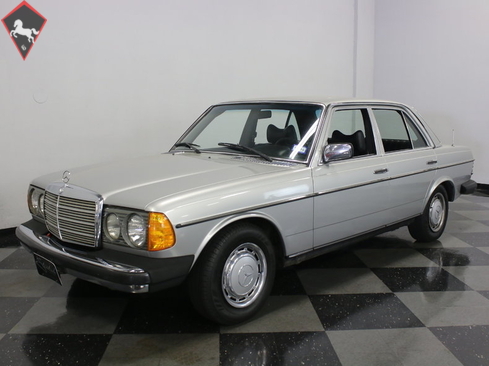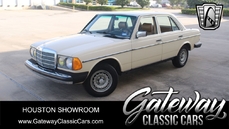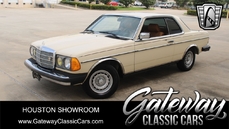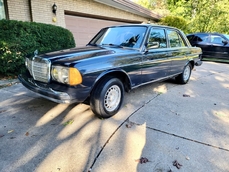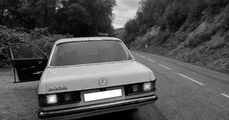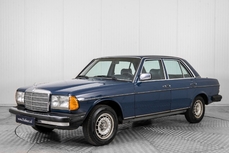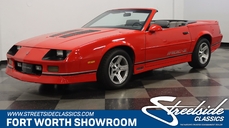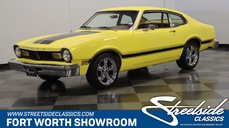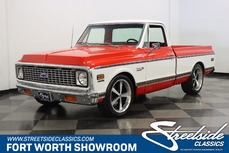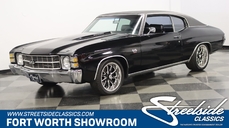Mercedes-Benz 300D w123 3L Straight 5 1977
General description :
ALWAYS A TEXAS CAR, CLEAN & WELL MAINTAINED 3L DIESEL, RUNS GREAT, LOOKS SHARP!
When gas prices spiked a few years ago, cars like this 1977 Mercedes-Benz 300D were suddenly very much in demand. Virtually indestructible and capable of pulling down some rather impressive fuel economy, they're always the first go-to vehicles when times get tough. The fact that you can enjoy Mercedes-levels of luxury while you save money is simply icing on the cake.
Yes, I'd call these desirable, if not collectable, because good ones never remain on the market for long. This one shows 42,257 miles, and since Mercedes odometers go to a million before rolling over, we'll let you make of it what you will, but there's absolutely no way this car has more than a million miles. However, it would also be a mistake to bet against it eventually running a million miles because these are perhaps the most reliable machines ever devised by man. The W123 series cars were notorious for rusting in northern climates, but this one has lived its entire life in warm, dry Texas, so the sheetmetal is as well-preserved as the mechanicals. The silver paint is probably an older repaint, but then again, given how beautifully preserved it is overall, perhaps it's the factory enamel after all. Either way, it's very nicely preserved and shows only a few signs of age but no injuries or problems lurking under the skin. The chrome and stainless trim remains very good as well, including the familiar Mercedes-Benz grille, which is still one of the most recognized symbols of wealth and quality on the road.
The black MB-Tex interior is in excellent shape, which shouldn't be a surprise because the stuff wears like iron. The bucket seats show no notable signs of wear (another point in favor of the mileage claims) and there aren't many cars that are better long-distance cruisers than this, as long as your bladder can withstand the miserly fuel economy and range. It is still a Mercedes, after all, so you get a beautiful burled walnut instrument panel and console, a giant steering wheel, and big, round gauges that should look familiar to anyone who has driven one of these in the past few decades. There's also a Becker AM/FM radio that's worth restoring or could be worth a pile of cash to a restorer if you choose to upgrade. There's also automatic climate control and power windows, so this affordable Benz is hardly stripped down. Plenty of room in back and the trunk will handle all the luggage you can carry.
The 300D nomenclature suggests a diesel 3.0 liter inline-5 (yes, five cylinders), which was a mainstay of Mercedes-Benz production for many years. If you see a Mercedes in Morocco pulling taxi duty, this is what's powering it. Indestructible, easy to maintain, and with fuel economy that will rival the best of today's cars, it's all about having your cake and eating it too. They're legendary for their durability and should run practically forever with basic maintenance. This one has been very well maintained along the way, but you'll probably find that oil changes and an occasional wash and wax are all it asks. It starts easily and idles with a familiar diesel clatter, and while the horsepower and torque figures are modest, this car will cruise all day at 75 MPH with the engine just purring away up front. You can also thank the 4-speed automatic transmission and tall rear gears, which certainly help in the economy department, and the suspension and brakes make it feel lively yet comfortable on the road. Like I said, there aren't many better road trip vehicles. Standard steel wheels with color-matched hubcaps look great and carry relatively recent 195/70/14 Michelin radials.
A Mercedes is always a Mercedes, but when it's so affordable and will pay you back with astounding fuel economy and reliability, you can count it as a double win. Call today!
Features : Defrost, Numbers Matching, AM/FM Radio, Sunroof, Air Conditioning, Heat, Leather Seats, Power Brakes, Power Steering, Power Windows, Seatbelts
http://www.streetsideclassics.com/vehicles/2019-dfw/1977-mercedes-benz-300d
1977 Mercedes-Benz 300D w123 3L Straight 5 is listed sold on ClassicDigest in Fort Worth by Streetside Classics for $12995.
Car Facts
Car type : Car Make : Mercedes-Benz Model : 300D w123 Model Version : 3L Straight 5 Engine size : 0.0 Model Year : 1977 Sub type : Sedan Location : Dallas/Fort Worth
Sold
Seller Information
Sold
People who viewed this Mercedes-Benz 300D w123 also viewed similar Mercedes-Benz listed at ClassicDigest
Other cars listed for sale by this dealer
About Mercedes-Benz
In the annals of automotive history, the journey of Mercedes-Benz is a tale that unfolds with the ingenuity of its founding pioneers. In the year 1886, Karl Benz crafted the Benz Patent Motorwagen, a creation that would go down in history as the world's inaugural automobile. Unbeknownst to him, this moment marked the genesis of what would evolve into the most illustrious premium car manufacturer globally. The financial underpinning of this pioneering venture, interestingly, was provided by Karl Benz's wife, Bertha Benz, demonstrating a remarkable partnership that would set the tone for Mercedes-Benz's legacy.A parallel narrative emerged not far away, as Daimler-Motoren-Gesellschaft, founded by Gottlieb Daimler and Wilhelm Maybach, entered the scene. In 1901, they unveiled their automobile under the now-famous moniker "Mercedes," meaning "godsend" in Spanish. This name was bestowed upon the car at the behest of Emil Jellinek's daughter, the distributor for Daimler-Motoren-Gesellschaft. The wheels of innovation were set in motion.
Fast forward to 1926, a pivotal year that witnessed the merger of Daimler with Benz & Cie., culminating in the birth of Daimler-Benz. The amalgamation saw the adoption of "Mercedes-Benz" as the distinguished trademark for their automobiles, fusing the legacies of two visionary entities into one.
Contrary to perceptions of conservatism, the trajectory of Daimler-Benz unfolds as a chronicle of industry firsts. From the introduction of the honeycomb radiator to the float carburetor, and the pioneering implementation of four-wheel brakes in 1924, Daimler-Benz consistently pushed the boundaries of automotive innovation. The diesel-powered Mercedes-Benz 260 D in 1936 marked the inception of diesel engines in passenger cars. The iconic Mercedes-Benz 300SL Gullwing made history as the first car with direct fuel injection, albeit the Gutbrod's tiny 2-stroke engine can claim precedence.
Safety innovations became a hallmark, with Béla Barényi's patented safety cell design in the "Ponton"-models in 1951, featuring front and rear crumple zones. The W116 450SEL 6.9 saw the introduction of the Anti-Lock Brake system (ABS), another pioneering safety feature. From the first production airbags and beyond, the legacy of "firsts" continued to be etched into the fabric of Daimler-Benz.
Over its centennial journey, Mercedes-Benz has not merely produced cars but has sculpted automotive icons. The SSKL, 710 SSK Trossi Roadster, 770K Grosser, 540K Spezial Roadster, 300SL Gullwing, w100 600 Pullman, w111 280SE 3.5 Flachkühler, w113 230SL Pagoda, w109 300 SEL 6.3, and w201 2.3-16 Cosworth stand testament to the brand's commitment to engineering excellence.
The roaring Silver Arrows, or "Silberpfeile," including the W 25, W 125, W154, W165, and W196, created a legacy of dominance on the racetrack. These machines were not merely cars; they were expressions of precision, speed, and an indomitable spirit that left their competitors in the dust.
As Mercedes-Benz marches into the future, it does so not just as an automaker but as a custodian of a legacy, a torchbearer of innovation, and a beacon of automotive excellence. The road ahead is sure to witness the continued fusion of cutting-edge technology, timeless design, and an unwavering commitment to setting new standards in the world of automobiles.
One luminary figure who left an indelible mark was Béla Barényi, often heralded as the "father of passive safety" for his pioneering work in safety engineering. His patented safety cell design, featuring front and rear crumple zones, became a hallmark of Mercedes-Benz's commitment to occupant safety, setting new standards that reverberated throughout the automotive world.
Moving through the chronicles, the collaborative genius of Wilhelm Maybach, alongside Gottlieb Daimler, laid the foundation for Daimler-Motoren-Gesellschaft. Their innovations not only birthed the first Mercedes but established a culture of relentless pursuit of technological excellence that remains integral to Mercedes-Benz's DNA.
In the post-merger era of 1926, Ferdinand Porsche emerged as a prominent figure within Mercedes-Benz. His work on the Mercedes-Benz S-Type, a supercharged race car, garnered acclaim and set the stage for a legacy that extended far beyond the marque. Porsche's impact would later extend to his eponymous company, but his influence at Mercedes-Benz during those formative years was pivotal.
As the 20th century progressed, the legendary Rudolf Uhlenhaut emerged as a key figure. Uhlenhaut, an accomplished engineer and the driving force behind the iconic Silver Arrows, played a crucial role in Mercedes-Benz's dominance in motorsports. His engineering prowess and attention to detail were instrumental in creating some of the most formidable racing cars of the era.
In the latter half of the century, figures like Bruno Sacco, the head of design at Mercedes-Benz from 1975 to 1999, left an indelible imprint on the brand's aesthetic identity. Sacco's design philosophy, characterized by clean lines and timeless elegance, shaped iconic models like the W126 S-Class and the W201 190E, solidifying Mercedes-Benz's reputation for luxury and sophistication.
The narrative would be incomplete without acknowledging the contributions of engineers like Hans Scherenberg, whose leadership in the 1970s ushered in a new era of technological innovation at Mercedes-Benz. Scherenberg's tenure saw the development of groundbreaking technologies, including the Anti-Lock Brake system (ABS) and the introduction of airbags in production cars.
